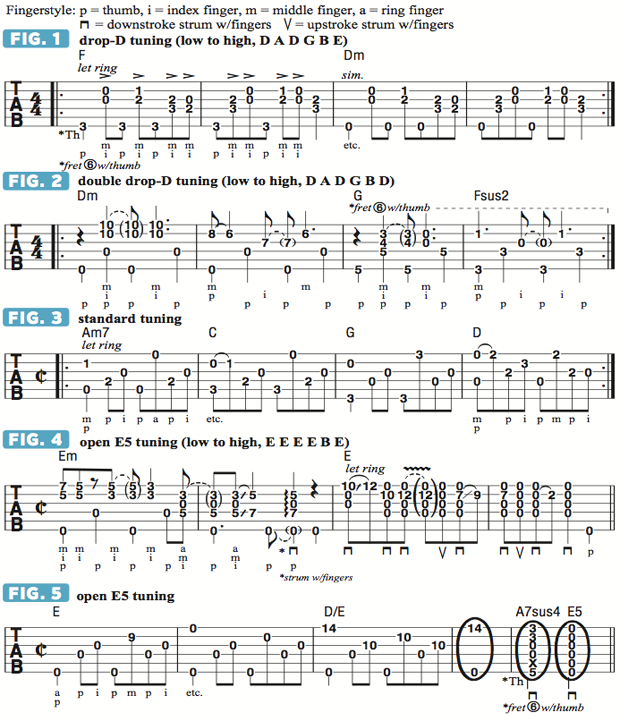The Deft Fingerpicking and Odd-Tuning Riffage of Stephen Stills

Stephen Stills’ status as a rock legend stems just as much from his singing and songwriting contributions in Buffalo Springfield, Crosby, Stills & Nash (and Young) and his own solo work as it does from his innovative acoustic and electric guitar offerings.
A hybrid stylist steeped in rock, blues, gospel, Latin, country and folk, Stills’ unique acoustic approach mixes a variety of fingerpicking techniques, a distinctive tone, and assorted odd tunings—one of which comprises only the notes E and B!
He counts Joe Bonamassa, Ray LaMontagne and Kenny Wayne Shepherd (with whom Stills recently collaborated on the Rides’ Can’t Get Enough) as some of his many guitar celebrity fans.
Let’s dig deep into this ax man’s bag of finger tricks. Buffalo Springfield’s roots trace back to Stills’ and songwriting guitarist Richie Furay’s early stints with the Au Go Go Singers (a nine-voice harmonizing group); a tour took them to Canada, where they met Neil Young.
By 1966, the three converged in California, added bassist Bruce Palmer to the mix and quickly became the Whisky a Go Go’s “house band,” issuing Buffalo Springfield by year’s end. But it was Buffalo Springfield Again that contained breakout hits like “Rock & Roll Woman,” Stills’ signature drop-D-tuned double-stop riff informing FIGURE 1.
This song was the result of a jam at Byrds member David Crosby’s house, an interesting fact given that months later, tensions within the Byrds, Hollies (with Graham Nash) and Buffalo Springfield camps would lead to the formation of Crosby, Stills & Nash. During this “band turmoil,” Stills, on April 26, 1968, took matters into his own hands and recorded a songwriter demo. Previously considered “lost,” these gems were commercially released in 2007 as Just Roll Tape, a guitar-and-vocal-only demo containing many future classics.
Among these is the double-drop-D-tuned “Treetop Flyer,” akin to FIGURE 2, a nod to Stills’ Chet Atkins influence. Ray LaMontagne has continuously cited this track (first officially released on 1991’s Stills Alone) as the inspiration for his musical career path. In 1969, Crosby, Stills & Nash released their self-titled debut, showcasing their unique three-part vocal harmonies and layered acoustic guitars—the polar opposite of the era’s blues-based “loud guitar” rock, as popularized by bands like Cream, Led Zeppelin and the Doors.
CSN contains many of Stills’ best-known songs, among them “Helplessly Hoping,” a standard-tuned gem propelled by fingerpicking similar to what you see in FIGURE 3.
CSN also introduced the world to “Bruce Palmer modal tuning” (low to high: E E E E B E), which Stills learned from the former Buffalo Springfield bassist and used in “Suite: Judy Blue Eyes,” as well as Déjà vu (CSN’s follow-up album with Neil Young) cuts like “4+20,” “Carry On” and “Word Game” from Stills’ 1971 solo album, Stephen Stills 2. Detune your A string to match the low open E, raise the D string one whole step to E, then detune the G string to match the open fourth string; this creates unison E notes on the bottom two and middle two strings.
FIGURES 4-5 show a mix of moves in this tuning, inspired by the aforementioned Stills songs.

Musician’s Institute instructor and author/transcriber Dale Turner played all the instruments/voices on his latest CD, Mannerisms Magnified. Visit intimateaudio.com for more information.
Get The Pick Newsletter
All the latest guitar news, interviews, lessons, reviews, deals and more, direct to your inbox!
A singer-songwriter/multi-instrumentalist/film composer, Musician's Institute instructor, and author of 50+ transcription/instructional books, Dale Turner is also Guitar World's "Hole Notes"/"Acoustic Nation" columnist, and the former West Coast Editor of Guitar One magazine. Some of Dale’s old, weird, rare, and/or exotic instruments are featured in his score for WEEDS, the first animated short completed within the Filmmakers Co-op at Disney Feature Animation. His most recent CD, Mannerisms Magnified, was praised by Guitar Player magazine for its "Smart pop tunes that are crammed with interesting guitar parts and tones ... Like what the Beach Boys might do if they were on an acid trip that was on the verge of getting out of control. Yeah!"










![Joe Bonamassa [left] wears a deep blue suit and polka-dotted shirt and plays his green refin Strat; the late Irish blues legend Rory Gallagher [right] screams and inflicts some punishment on his heavily worn number one Stratocaster.](https://cdn.mos.cms.futurecdn.net/cw28h7UBcTVfTLs7p7eiLe.jpg)
![[from left] George Harrison with his Gretsch Country Gentleman, Norman Harris of Norman's Rare Guitars holds a gold-top Les Paul, John Fogerty with his legendary 1969 Rickenbacker](https://cdn.mos.cms.futurecdn.net/TuH3nuhn9etqjdn5sy4ntW.jpg)